This is “Refining Your Writing: How Do I Improve My Writing Technique?”, chapter 7 from the book Successful Writing (v. 1.0). For details on it (including licensing), click here.
For more information on the source of this book, or why it is available for free, please see the project's home page. You can browse or download additional books there. To download a .zip file containing this book to use offline, simply click here.
Chapter 7 Refining Your Writing: How Do I Improve My Writing Technique?
7.1 Sentence Variety
Learning Objectives
- Identify ways to vary sentence structure.
- Write and revise sentence structure at the beginning of sentences.
- Write and revise sentence structure by connecting ideas.
Have you ever ordered a dish in a restaurant and been not happy with its taste, even though it contained most of your favorite ingredients? Just as a meal might lack the finishing touches needed to spice it up, so too might a paragraph contain all the basic components but still lack the stylistic finesse required to engage a reader. Sometimes writers have a tendency to reuse the same sentence pattern throughout their writing. Like any repetitive task, reading text that contains too many sentences with the same length and structure can become monotonous and boring. Experienced writers mix it up by using an assortment of sentence patterns, rhythms, and lengths.
In this chapter, you will follow a student named Naomi who has written a draft of an essay but needs to refine her writing. This section discusses how to introduce sentence variety into writing, how to open sentences using a variety of techniques, and how to use different types of sentence structure when connecting ideas. You can use these techniques when revising a paper to bring life and rhythm to your work. They will also make reading your work more enjoyable.
Incorporating Sentence Variety
Experienced writers incorporate sentence varietyUse of an assortment of sentence patterns, rhythms, and lengths to reduce repetition and emphasize important points in a text. into their writing by varying sentence style and structure. Using a mixture of different sentence structures reduces repetition and adds emphasis to important points in the text. Read the following example:
During my time in office I have achieved several goals. I have helped increase funding for local schools. I have reduced crime rates in the neighborhood. I have encouraged young people to get involved in their community. My competitor argues that she is the better choice in the upcoming election. I argue that it is ridiculous to fix something that isn’t broken. If you reelect me this year, I promise to continue to serve this community.
In this extract from an election campaign, the writer uses short, simple sentences of a similar length and style. Writers often mistakenly believe that this technique makes the text more clear for the reader, but the result is a choppy, unsophisticated paragraph that does not grab the audience’s attention. Now read the revised paragraph with sentence variety:
During my time in office, I have helped increase funding for local schools, reduced crime rates in the neighborhood, and encouraged young people to get involved in their community. Why fix what isn’t broken? If you reelect me this year, I will continue to achieve great things for this community. Don’t take a chance on an unknown contender; vote for the proven success.
Notice how introducing a short rhetorical question among the longer sentences in the paragraph is an effective means of keeping the reader’s attention. In the revised version, the writer combines the choppy sentences at the beginning into one longer sentence, which adds rhythm and interest to the paragraph.
Tip
Effective writers often implement the “rule of three,” which is basically the thought that things that contain three elements are more memorable and more satisfying to readers than any other number. Try to use a series of three when providing examples, grouping adjectives, or generating a list.
Exercise 1
Combine each set of simple sentences into a compound or a complex sentence. Write the combined sentence on your own sheet of paper.
- Heroin is an extremely addictive drug. Thousands of heroin addicts die each year.
- Shakespeare’s writing is still relevant today. He wrote about timeless themes. These themes include love, hate, jealousy, death, and destiny.
- Gay marriage is now legal in six states. Iowa, Massachusetts, Connecticut, Vermont, New Hampshire, and Maine all permit same-sex marriage. Other states are likely to follow their example.
- Prewriting is a vital stage of the writing process. Prewriting helps you organize your ideas. Types of prewriting include outlining, brainstorming, and idea mapping.
- Mitch Bancroft is a famous writer. He also serves as a governor on the local school board. Mitch’s two children attend the school.
Collaboration
Please share with a classmate and compare your answers.
Using Sentence Variety at the Beginning of Sentences
Read the following sentences and consider what they all have in common:
John and Amanda will be analyzing this week’s financial report.
The car screeched to a halt just a few inches away from the young boy.
Students rarely come to the exam adequately prepared.
If you are having trouble figuring out why these sentences are similar, try underlining the subject in each. You will notice that the subject is positioned at the beginning of each sentence—John and Amanda, the car, students. Since the subject-verb-object pattern is the simplest sentence structure, many writers tend to overuse this technique, which can result in repetitive paragraphs with little sentence variety.
Naomi wrote an essay about the 2008 government bailout. Read this excerpt from Naomi’s essay:

This section examines several ways to introduce sentence variety at the beginning of sentences, using Naomi’s essay as an example.
Starting a Sentence with an Adverb
One technique you can use so as to avoid beginning a sentence with the subject is to use an adverb. An adverbA word that describes a verb, adjective, or other adverb and often ends in -ly. is a word that describes a verb, adjective, or other adverb and often ends in -ly. Examples of adverbs include quickly, softly, quietly, angrily, and timidly. Read the following sentences:
She slowly turned the corner and peered into the murky basement.
Slowly, she turned the corner and peered into the murky basement.
In the second sentence, the adverb slowly is placed at the beginning of the sentence. If you read the two sentences aloud, you will notice that moving the adverb changes the rhythm of the sentence and slightly alters its meaning. The second sentence emphasizes how the subject moves—slowly—creating a buildup of tension. This technique is effective in fictional writing.
Note that an adverb used at the beginning of a sentence is usually followed by a comma. A comma indicates that the reader should pause briefly, which creates a useful rhetorical device. Read the following sentences aloud and consider the effect of pausing after the adverb:
Cautiously, he unlocked the kennel and waited for the dog’s reaction.
Solemnly, the policeman approached the mayor and placed him under arrest.
Suddenly, he slammed the door shut and sprinted across the street.
In an academic essay, moving an adverb to the beginning of a sentence serves to vary the rhythm of a paragraph and increase sentence variety.

Naomi has used two adverbs in her essay that could be moved to the beginning of their respective sentences. Notice how the following revised version creates a more varied paragraph:

Tip
Adverbs of time—adverbs that indicate when an action takes place—do not always require a comma when used at the beginning of a sentence. Adverbs of time include words such as yesterday, today, later, sometimes, often, and now.
Exercise 2
On your own sheet of paper, rewrite the following sentences by moving the adverbs to the beginning.
- The red truck sped furiously past the camper van, blaring its horn.
- Jeff snatched at the bread hungrily, polishing off three slices in under a minute.
- Underage drinking typically results from peer pressure and lack of parental attention.
- The firefighters bravely tackled the blaze, but they were beaten back by flames.
- Mayor Johnson privately acknowledged that the budget was excessive and that further discussion was needed.
Collaboration
Please share with a classmate and compare your answers.
Starting a Sentence with a Prepositional Phrase
A prepositional phraseA group of words that begins with a preposition. is a group of words that behaves as an adjective or an adverb, modifying a noun or a verb. Prepositional phrases contain a prepositionA word that connects a noun, pronoun, or verb to another word that describes or modifies it. Common prepositions include in, on, under, near, by, with, and about. (a word that specifies place, direction, or time) and an object of the prepositionA noun phrase or pronoun that follows a preposition and completes its meaning. (a noun phrase or pronoun that follows the preposition).
Table 7.1 Common Prepositions
| above | beneath | into | till |
| across | beside | like | toward |
| against | between | near | under |
| after | beyond | off | underneath |
| among | by | on | until |
| around | despite | over | up |
| at | except | past | with |
| before | for | since | without |
| behind | from | through | |
| below | inside | throughout |
Read the following sentence:
The terrified child hid underneath the table.
In this sentence, the prepositional phrase is underneath the table. The preposition underneath relates to the object that follows the preposition—the table. Adjectives may be placed between the preposition and the object in a prepositional phrase.
The terrified child hid underneath the heavy wooden table.
Some prepositional phrases can be moved to the beginning of a sentence in order to create variety in a piece of writing. Look at the following revised sentence:
Underneath the heavy wooden table, the terrified child hid.
Notice that when the prepositional phrase is moved to the beginning of the sentence, the emphasis shifts from the subject—the terrified child—to the location in which the child is hiding. Words that are placed at the beginning or end of a sentence generally receive the greatest emphasis. Take a look at the following examples. The prepositional phrase is underlined in each:
The bandaged man waited in the doctor’s office.
In the doctor’s office, the bandaged man waited.
My train leaves the station at 6:45 a.m.
At 6:45 a.m., my train leaves the station.
Teenagers exchange drugs and money under the railway bridge.
Under the railway bridge, teenagers exchange drugs and money.
Prepositional phrases are useful in any type of writing. Take another look at Naomi’s essay on the government bailout.

Now read the revised version.

The underlined words are all prepositional phrases. Notice how they add additional information to the text and provide a sense of flow to the essay, making it less choppy and more pleasurable to read.
Unmovable Prepositional Phrases
Not all prepositional phrases can be placed at the beginning of a sentence. Read the following sentence:
I would like a chocolate sundae without whipped cream.
In this sentence, without whipped cream is the prepositional phrase. Because it describes the chocolate sundae, it cannot be moved to the beginning of the sentence. “Without whipped cream I would like a chocolate sundae” does not make as much (if any) sense. To determine whether a prepositional phrase can be moved, we must determine the meaning of the sentence.
Overuse of Prepositional Phrases
Experienced writers often include more than one prepositional phrase in a sentence; however, it is important not to overload your writing. Using too many modifiers in a paragraph may create an unintentionally comical effect as the following example shows:
The treasure lay buried under the old oak tree, behind the crumbling fifteenth-century wall, near the schoolyard, where children played merrily during their lunch hour, unaware of the riches that remained hidden beneath their feet.
A sentence is not necessarily effective just because it is long and complex. If your sentence appears cluttered with prepositional phrases, divide it into two shorter sentences. The previous sentence is far more effective when written as two simpler sentences:
The treasure lay buried under the old oak tree, behind the crumbling fifteenth-century wall. In the nearby schoolyard, children played merrily during their lunch hour, unaware of the riches that remained hidden beneath their feet.
Writing at Work
The overuse of prepositional phrases often occurs when our thoughts are jumbled and we are unsure how concepts or ideas relate to one another. If you are preparing a report or a proposal, take the time to organize your thoughts in an outline before writing a rough draft. Read the draft aloud, either to yourself or to a colleague, and identify areas that are rambling or unclear. If you notice that a particular part of your report contains several sentences over twenty words, you should double check that particular section to make certain that it is coherent and does not contain unnecessary prepositional phrases. Reading aloud sometimes helps detect unclear and wordy sentences. You can also ask a colleague to paraphrase your main points to ensure that the meaning is clear.
Starting a Sentence by Inverting Subject and Verb
As we noted earlier, most writers follow the subject-verb-object sentence structure. In an inverted sentenceA sentence that inverts the traditional subject-verb-object structure so that the verb follows the subject., the order is reversed so that the subject follows the verb. Read the following sentence pairs:
- A truck was parked in the driveway.
- Parked in the driveway was a truck.
- A copy of the file is attached.
- Attached is a copy of the file.
Notice how the second sentence in each pair places more emphasis on the subject—a truck in the first example and the file in the second. This technique is useful for drawing the reader’s attention to your primary area of focus. We can apply this method to an academic essay. Take another look at Naomi’s paragraph.

To emphasize the subject in certain sentences, Naomi can invert the traditional sentence structure. Read her revised paragraph:

Notice that in the first underlined sentence, the subject (some economists) is placed after the verb (argued). In the second underlined sentence, the subject (the government) is placed after the verb (expects).
Exercise 3
On your own sheet of paper, rewrite the following sentences as inverted sentences.
- Teresa will never attempt to run another marathon.
- A detailed job description is enclosed with this letter.
- Bathroom facilities are across the hall to the left of the water cooler.
- The well-dressed stranger stumbled through the doorway.
- My colleagues remain unconvinced about the proposed merger.
Collaboration
Please share with a classmate and compare your answers.
Connecting Ideas to Increase Sentence Variety
Reviewing and rewriting the beginning of sentences is a good way of introducing sentence variety into your writing. Another useful technique is to connect two sentences using a modifier, a relative clause, or an appositive. This section examines how to connect ideas across several sentences in order to increase sentence variety and improve writing.
Joining Ideas Using an -ing Modifier
Sometimes it is possible to combine two sentences by converting one of them into a modifier using the -ing verb form—singing, dancing, swimming. A modifierA word or phrase that qualifies the meaning of another element in a sentence. is a word or phrase that qualifies the meaning of another element in the sentence. Read the following example:
Original sentences: Steve checked the computer system. He discovered a virus.
Revised sentence: Checking the computer system, Steve discovered a virus.
To connect two sentences using an -ing modifier, add -ing to one of the verbs in the sentences (checking) and delete the subject (Steve). Use a comma to separate the modifier from the subject of the sentence. It is important to make sure that the main idea in your revised sentence is contained in the main clause, not in the modifier. In this example, the main idea is that Steve discovered a virus, not that he checked the computer system.
In the following example, an -ing modifier indicates that two actions are occurring at the same time:
-
Noticing the police car, she shifted gears and slowed down.
This means that she slowed down at the same time she noticed the police car.
-
Barking loudly, the dog ran across the driveway.
This means that the dog barked as it ran across the driveway.
You can add an -ing modifier to the beginning or the end of a sentence, depending on which fits best.
Beginning: Conducting a survey among her friends, Amanda found that few were happy in their jobs.
End: Maria filed the final report, meeting her deadline.
Dangling Modifiers
A common mistake when combining sentences using the -ing verb form is to misplace the modifier so that it is not logically connected to the rest of the sentence. This creates a dangling modifierA modifier that is not logically connected to the rest of the sentence.. Look at the following example:
Jogging across the parking lot, my breath grew ragged and shallow.
In this sentence, jogging across the parking lot seems to modify my breath. Since breath cannot jog, the sentence should be rewritten so that the subject is placed immediately after the modifier or added to the dangling phrase.
Jogging across the parking lot, I felt my breath grow ragged and shallow.
For more information on dangling modifiers, see Chapter 2 "Writing Basics: What Makes a Good Sentence?".
Joining Ideas Using an -ed Modifier
Some sentences can be combined using an -ed verb form—stopped, finished, played. To use this method, one of the sentences must contain a form of be as a helping verb in addition to the -ed verb form. Take a look at the following example:
Original sentences: The Jones family was delayed by a traffic jam. They arrived several hours after the party started.
Revised sentence: Delayed by a traffic jam, the Jones family arrived several hours after the party started.
In the original version, was acts as a helping verbA verb that is used with a main verb to describe mood or tense. The helping verb is usually a form of be, do, or have.—it has no meaning by itself, but it serves a grammatical function by placing the main verb (delayed) in the perfect tense.
To connect two sentences using an -ed modifier, drop the helping verb (was) and the subject (the Jones family) from the sentence with an -ed verb form. This forms a modifying phrase (delayed by a traffic jam) that can be added to the beginning or end of the other sentence according to which fits best. As with the -ing modifier, be careful to place the word that the phrase modifies immediately after the phrase in order to avoid a dangling modifier.
Using -ing or -ed modifiers can help streamline your writing by drawing obvious connections between two sentences. Take a look at how Naomi might use modifiers in her paragraph.

The revised version of the essay uses the -ing modifier opting to draw a connection between the government’s decision to bail out the banks and the result of that decision—the acquisition of the mortgage-backed securities.
Joining Ideas Using a Relative Clause
Another technique that writers use to combine sentences is to join them using a relative clause. A relative clauseA group of words that contains a subject and a verb and describes a noun. A relative clause functions as an adjective in a sentence. is a group of words that contains a subject and a verb and describes a noun. Relative clauses function as adjectives by answering questions such as which one? or what kind? Relative clauses begin with a relative pronoun, such as who, which, where, why, or when. Read the following examples:
Original sentences: The managing director is visiting the company next week. He lives in Seattle.
Revised sentence: The managing director, who lives in Seattle, is visiting the company next week.
To connect two sentences using a relative clause, substitute the subject of one of the sentences (he) for a relative pronoun (who). This gives you a relative clause (who lives in Seattle) that can be placed next to the noun it describes (the managing director). Make sure to keep the sentence you want to emphasize as the main clause. For example, reversing the main clause and subordinate clause in the preceding sentence emphasizes where the managing director lives, not the fact that he is visiting the company.
Revised sentence: The managing director, who is visiting the company next week, lives in Seattle.
Relative clauses are a useful way of providing additional, nonessential information in a sentence. Take a look at how Naomi might incorporate relative clauses into her essay.

Notice how the underlined relative clauses can be removed from Naomi’s essay without changing the meaning of the sentence.
Tip
To check the punctuation of relative clauses, assess whether or not the clause can be taken out of the sentence without changing its meaning. If the relative clause is not essential to the meaning of the sentence, it should be placed in commas. If the relative clause is essential to the meaning of the sentence, it does not require commas around it.
Joining Ideas Using an Appositive
An appositiveA word or group of words that describes or renames a noun or pronoun. is a word or group of words that describes or renames a noun or pronoun. Incorporating appositives into your writing is a useful way of combining sentences that are too short and choppy. Take a look at the following example:
Original sentences: Harland Sanders began serving food for hungry travelers in 1930. He is Colonel Sanders or “the Colonel.”
Revised sentence: Harland Sanders, “the Colonel,” began serving food for hungry travelers in 1930.
In the revised sentence, “the Colonel” is an appositive because it renames Harland Sanders. To combine two sentences using an appositive, drop the subject and verb from the sentence that renames the noun and turn it into a phrase. Note that in the previous example, the appositive is positioned immediately after the noun it describes. An appositive may be placed anywhere in a sentence, but it must come directly before or after the noun to which it refers:
Appositive after noun: Scott, a poorly trained athlete, was not expected to win the race.
Appositive before noun: A poorly trained athlete, Scott was not expected to win the race.
Unlike relative clauses, appositives are always punctuated by a comma or a set commas. Take a look at the way Naomi uses appositives to include additional facts in her essay.

Exercise 4
On your own sheet of paper, rewrite the following sentence pairs as one sentence using the techniques you have learned in this section.
- Baby sharks are called pups. Pups can be born in one of three ways.
- The Pacific Ocean is the world’s largest ocean. It extends from the Arctic in the north to the Southern Ocean in the south.
- Michael Phelps won eight gold medals in the 2008 Olympics. He is a champion swimmer.
- Ashley introduced her colleague Dan to her husband, Jim. She speculated that the two of them would have a lot in common.
- Cacao is harvested by hand. It is then sold to chocolate-processing companies at the Coffee, Sugar, and Cocoa Exchange.
Collaboration
Please share with a classmate and compare your answers.
Writing at Work
In addition to varying sentence structure, consider varying the types of sentences you are using in a report or other workplace document. Most sentences are declarative, but a carefully placed question, exclamation, or command can pique colleagues’ interest, even if the subject material is fairly dry. Imagine that you are writing a budget analysis. Beginning your report with a rhetorical question, such as “Where is our money going?” or “How can we increase sales?” encourages people to continue reading to find out the answers. Although they should be used sparingly in academic and professional writing, questions or commands are effective rhetorical devices.
Key Takeaways
- Sentence variety reduces repetition in a piece of writing and adds emphasis to important points in the text.
- Sentence variety can be introduced to the beginning of sentences by starting a sentence with an adverb, starting a sentence with a prepositional phrase, or by inverting the subject and verb.
- Combine ideas, using modifiers, relative clauses, or appositives, to achieve sentence variety.
7.2 Coordination and Subordination
Learning Objectives
- Identify coordination and subordination in writing.
- Combine sentences and ideas using coordination.
- Combine sentences and ideas using subordination.
In the previous section, we learned how to use different patterns to create sentence variety and to add emphasis to important points in our writing. Next, we will examine two ways in which we can join sentences with related ideas:
- CoordinationIt joins two related ideas of equal importance.. Joining two related ideas of equal importance.
- SubordinationIt joins two related ideas of unequal importance.. Joining two related ideas of unequal importance.
Connecting sentences with coordinate or subordinate clauses creates more coherent paragraphs, and in turn, produces more effective writing. In this section, you will read excerpts from Naomi’s classmate named Joshua, who drafted an essay about wine production. Read this excerpt from Joshua’s essay.
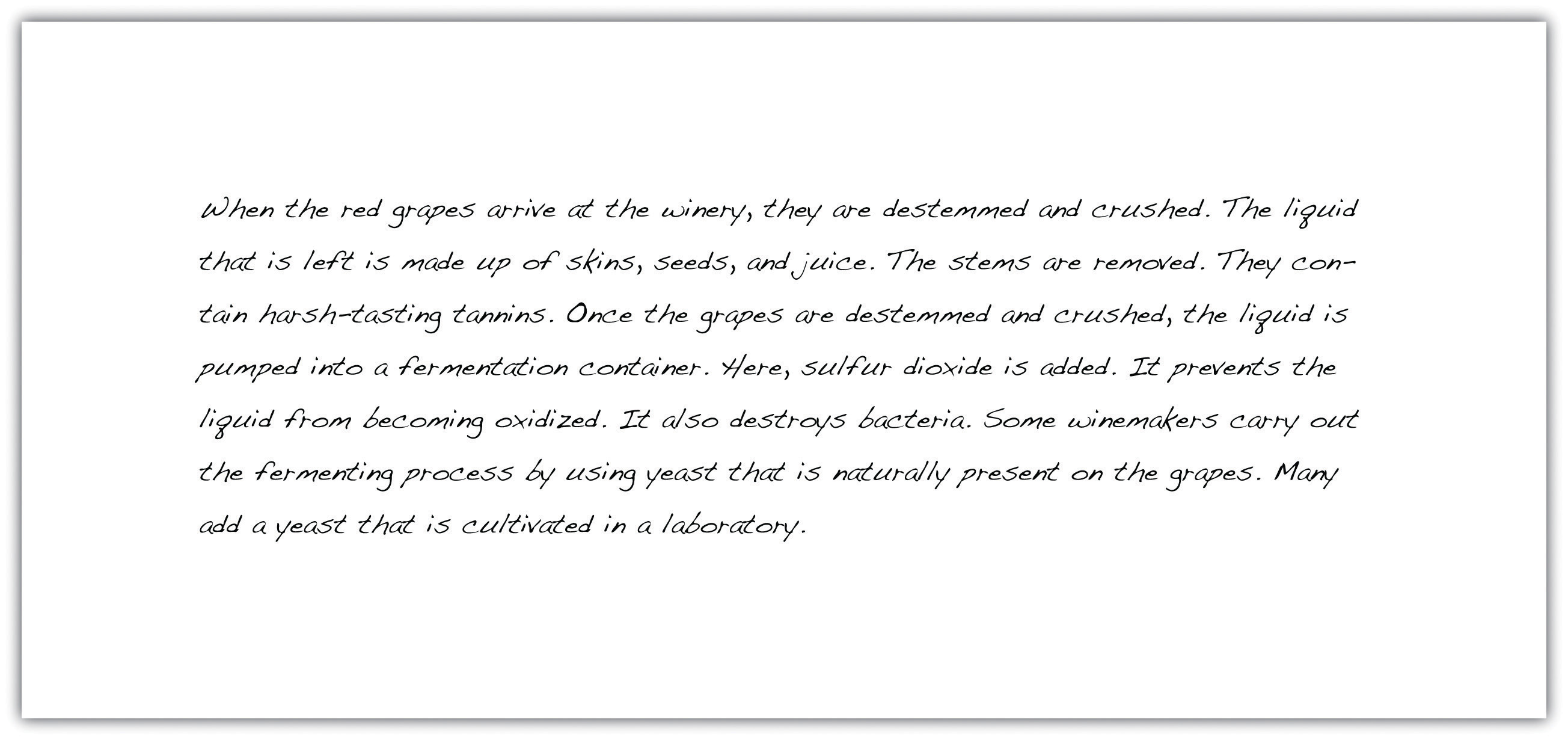
This section examines several ways to combine sentences with coordination and subordination, using Joshua’s essay as an example.
Coordination
Coordination joins two independent clauses that contain related ideas of equal importance.
Original sentences: I spent my entire paycheck last week. I am staying home this weekend.
In their current form, these sentences contain two separate ideas that may or may not be related. Am I staying home this week because I spent my paycheck, or is there another reason for my lack of enthusiasm to leave the house? To indicate a relationship between the two ideas, we can use the coordinating conjunction so:
Revised sentence: I spent my entire paycheck last week, so I am staying home this weekend.
The revised sentence illustrates that the two ideas are connected. Notice that the sentence retains two independent clauses (I spent my entire paycheck; I am staying home this weekend) because each can stand alone as a complete idea.
Coordinating Conjunctions
A coordinating conjunctionA linking word that joins two independent clauses. The seven common coordinating conjunctions are for, and, nor, but, or, yet, and, so. is a word that joins two independent clauses. The most common coordinating conjunctions are for, and, nor, but, or, yet, and so. Note that a comma precedes the coordinating conjunction when joining two clauses.
| Independent Clause | Coordinating Conjunction | Independent Clause | Revised Sentence |
|---|---|---|---|
| I will not be attending the dance. | for (indicates a reason or cause) | I have no one to go with. | I will not be attending the dance, for I have no one to go with. |
| I plan to stay home. | and (joins two ideas) | I will complete an essay for class. | I plan to stay home, and I will complete an essay for class. |
| Jessie isn’t going to be at the dance. | nor (indicates a negative) | Tom won’t be there either. | Jessie isn’t going to be at the dance, nor will Tom be there. |
| The fundraisers are hoping for a record-breaking attendance. | but (indicates a contrast) | I don’t think many people are going. | The fundraisers are hoping for a record-breaking attendance, but I don’t think many people are going. |
| I might go to the next fundraising event. | or (offers an alternative) | I might donate some money to the cause. | I might go to the next fundraising event, or I might donate some money to the cause. |
| My parents are worried that I am antisocial. | yet (indicates a reason) | I have many friends at school. | My parents are worried that I am antisocial, yet I have many friends at school. |
| Buying a new dress is expensive. | so (indicates a result) | By staying home I will save money. | Buying a new dress is expensive, so by staying home I will save money. |
Tip
To help you remember the seven coordinating conjunctions, think of the acronym FANBOYS: for, and, nor, but, or, yet, so. Remember that when you use a coordinating conjunction in a sentence, a comma should precede it.
Conjunctive Adverbs
Another method of joining two independent clauses with related and equal ideas is to use a conjunctive adverb and a semicolon (see Chapter 2 "Writing Basics: What Makes a Good Sentence?" for information on semicolon usage). A conjunctive adverbAn adverb that connects two clauses by describing the relationship between them. is a linking word that demonstrates a relationship between two clauses. Read the following sentences:
Original sentences: Bridget wants to take part in the next Olympics. She trains every day.
Since these sentences contain two equal and related ideas, they may be joined using a conjunctive adverb. Now, read the revised sentence:
Revised sentence: Bridget wants to take part in the next Olympics; therefore, she trains every day.
The revised sentence explains the relationship between Bridget’s desire to take part in the next Olympics and her daily training. Notice that the conjunctive adverb comes after a semicolon that separates the two clauses and is followed by a comma.
Review the following chart of some common conjunctive adverbs with examples of how they are used:
| Function | Conjunctive Adverb | Example |
|---|---|---|
| Addition | also, furthermore, moreover, besides | Alicia was late for class and stuck in traffic; furthermore, her shoe heel had broken and she had forgotten her lunch. |
| Comparison | similarly, likewise | Recycling aluminum cans is beneficial to the environment; similarly, reusing plastic bags and switching off lights reduces waste. |
| Contrast | instead, however, conversely | Most people do not walk to work; instead, they drive or take the train. |
| Emphasis | namely, certainly, indeed | The Siberian tiger is a rare creature; indeed, there are fewer than five hundred left in the wild. |
| Cause and Effect | accordingly, consequently, hence, thus | I missed my train this morning; consequently, I was late for my meeting. |
| Time | finally, next, subsequently, then | Tim crossed the barrier, jumped over the wall, and pushed through the hole in the fence; finally, he made it to the station. |
Take a look at Joshua’s essay on wine production and identify some areas in which he might use coordination.
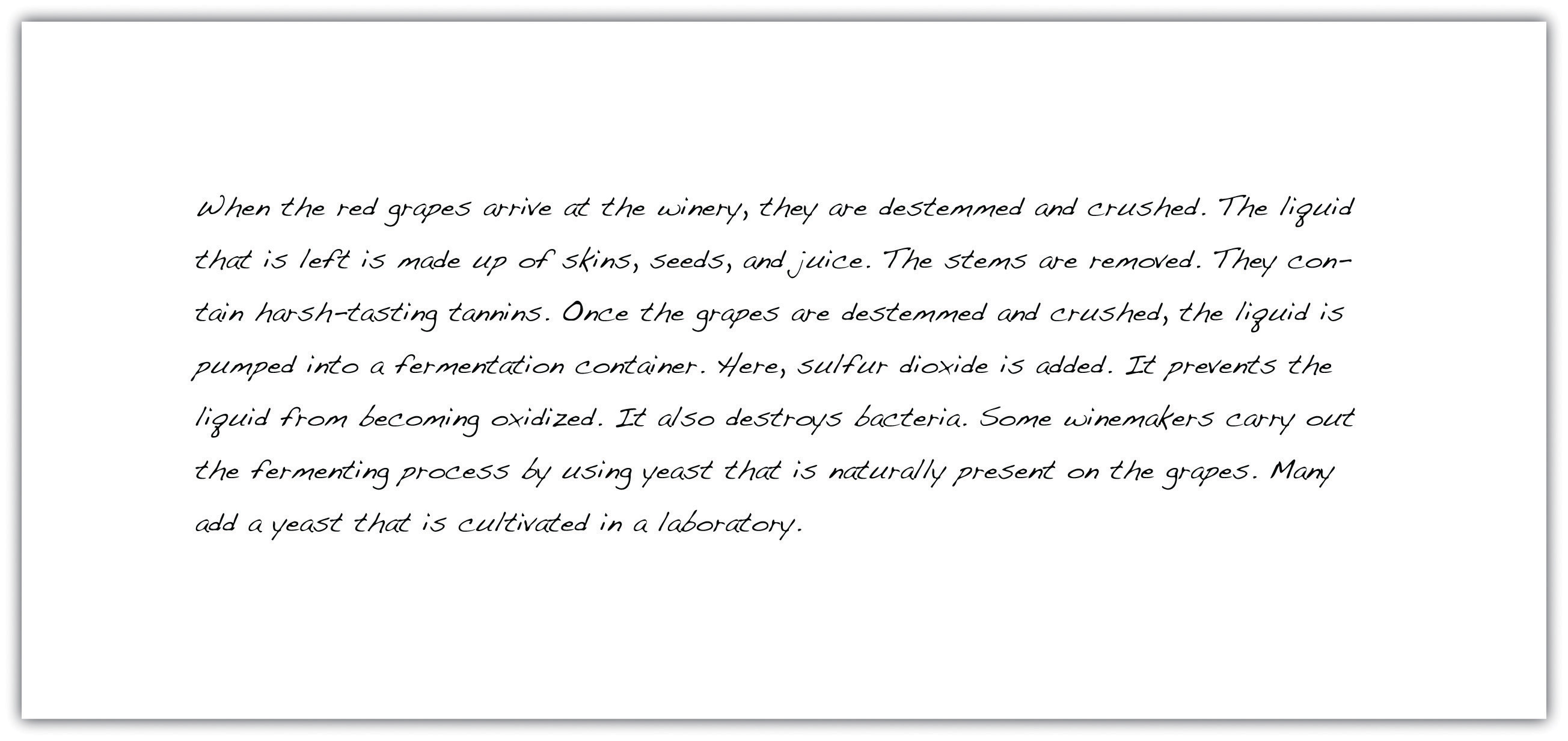
Now look at Joshua’s revised essay. Did you coordinate the same sentences? You may find that your answers are different because there are usually several ways to join two independent clauses.

Exercise 1
Combine each sentence pair into a single sentence using either a coordinating conjunction or a conjunctive adverb. Then copy the combined sentence onto your own sheet of paper.
- Pets are not allowed in Mr. Taylor’s building. He owns several cats and a parrot.
- New legislation prevents drivers from sending or reading text messages while driving. Many people continue to use their phones illegally.
- The coroner concluded that the young man had taken a lethal concoction of drugs. By the time his relatives found him, nothing could be done.
- Amphibians are vertebrates that live on land and in the water. Flatworms are invertebrates that live only in water.
- Ashley carefully fed and watered her tomato plants all summer. The tomatoes grew juicy and ripe.
- When he lost his car key, Simon attempted to open the door with a wire hanger, a credit card, and a paper clip. He called the manufacturer for advice.
Collaboration
Please share with a classmate and compare your answers.
Writing at Work
When writing an essay or a report, it is important that you do not use excessive coordination. Workplace documents should be clear and concise, so only join two clauses that are logically connected and can work together to make one main point. If you repeat the same coordinating conjunction several times in a sentence, you are probably including more than one idea. This may make it difficult for readers to pick out the most important information in each sentence.
Subordination
Subordination joins two sentences with related ideas by merging them into a main clauseA group of words that contain a subject and a verb and can stand alone as a complete thought. (a complete sentence) and a dependent clauseA group of words that contain a subject and verb but cannot stand alone as a complete thought. (a construction that relies on the main clause to complete its meaning). Coordination allows a writer to give equal weight to the two ideas that are being combined, and subordination enables a writer to emphasize one idea over the other. Take a look at the following sentences:
Original sentences: Tracy stopped to help the injured man. She would be late for work.
To illustrate that these two ideas are related, we can rewrite them as a single sentence using the subordinating conjunction even though.
Revised sentence: Even though Tracy would be late for work, she stopped to help the injured man.
In the revised version, we now have an independent clause (she stopped to help the injured man) that stands as a complete sentence and a dependent clause (even though Tracy would be late for work) that is subordinate to the main clause. Notice that the revised sentence emphasizes the fact that Tracy stopped to help the injured man, rather than the fact she would be late for work. We could also write the sentence this way:
Revised sentence: Tracy stopped to help the injured man even though she would be late for work.
The meaning remains the same in both sentences, with the subordinating conjunction even though introducing the dependent clause.
Tip
To punctuate sentences correctly, look at the position of the main clause and the subordinate clause. If a subordinate clause precedes the main clause, use a comma. If the subordinate clause follows the main cause, no punctuation is required.
Subordinating Conjunctions
A subordinating conjunctionA word that connects a subordinate (dependent) clause to an independent (main) clause. is a word that joins a subordinate (dependent) clause to a main (independent) clause. Review the following chart of some common subordinating conjunctions and examples of how they are used:
| Function | Subordinating Conjunction | Example |
|---|---|---|
| Concession | although, while, though, whereas, even though | Sarah completed her report even though she had to stay late to get it done. |
| Condition | if, unless, until | Until we know what is causing the problem, we will not be able to fix it. |
| Manner | as if, as, though | Everyone in the conference room stopped talking at once, as though they had been stunned into silence. |
| Place | where, wherever | Rita is in San Jose where she has several important client meetings. |
| Reason | because, since, so that, in order that | Because the air conditioning was turned up so high, everyone in the office wore sweaters. |
| Time | after, before, while, once, when | After the meeting had finished, we all went to lunch. |
Take a look at the excerpt from Joshua’s essay and identify some areas in which he might use subordination.
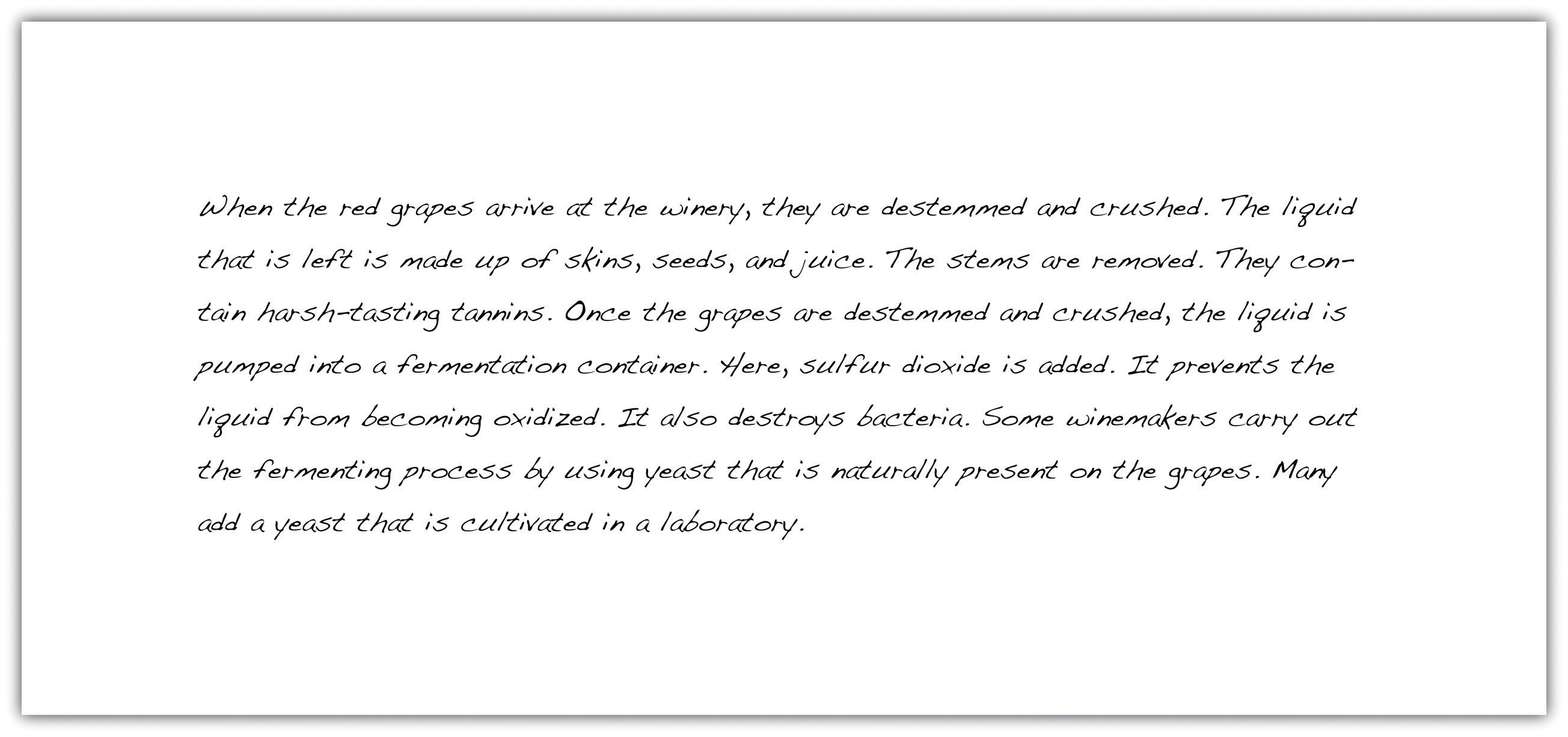
Now look at Joshua’s revised essay and compare your answers. You will probably notice that there are many different ways to subordinate sentences.
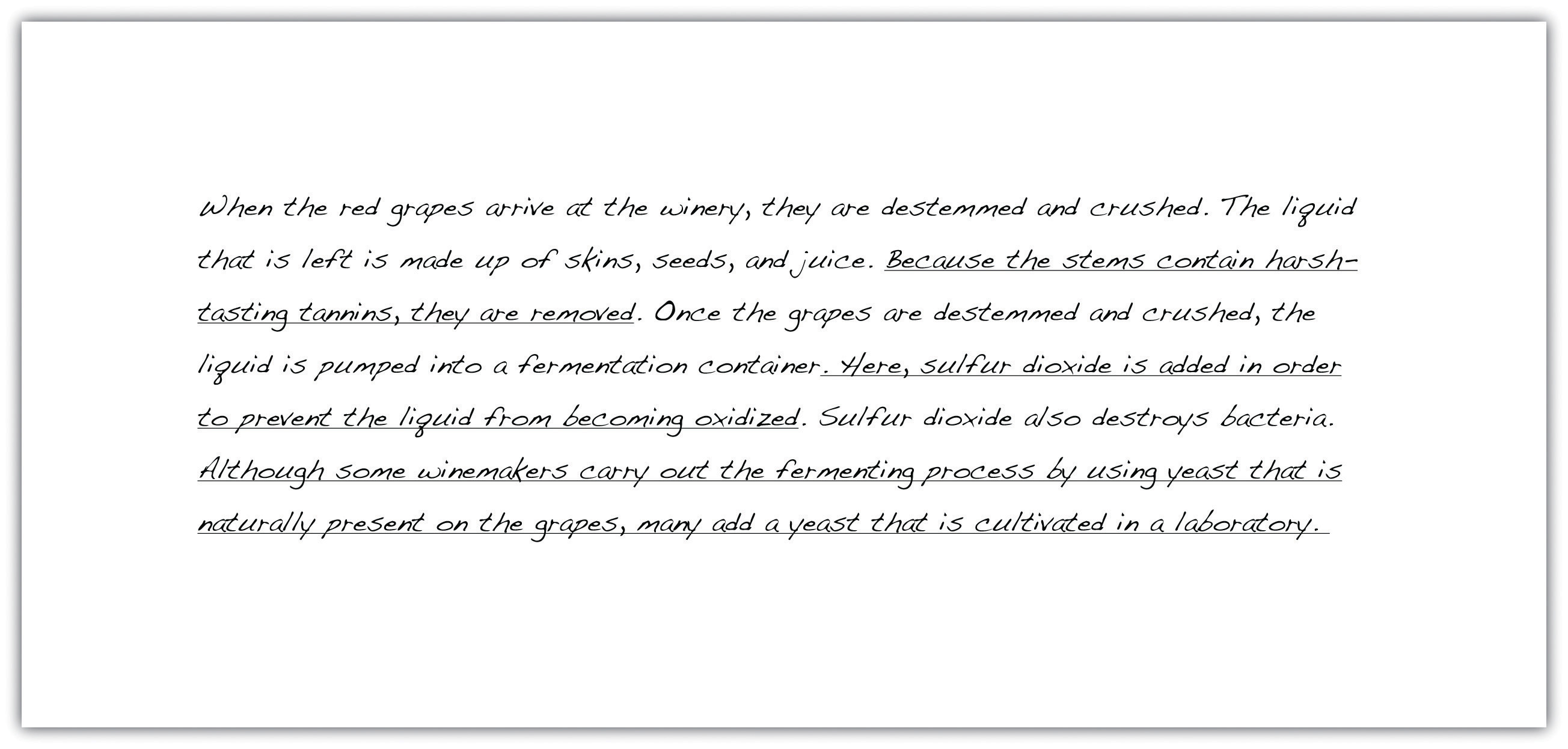
Exercise 2
Combine each sentence pair into a single sentence using a subordinating conjunction and then copy the combined sentence onto your own sheet of paper.
- Jake is going to Mexico. There are beautiful beaches in Mexico.
- A snowstorm disrupted traffic all over the east coast. There will be long delivery delays this week.
- My neighbor had his television volume turned up too high. I banged on his door and asked him to keep the noise down.
- Jessica prepared the potato salad and the sautéed vegetables. Ashley marinated the chicken.
- Romeo poisons himself. Juliet awakes to find Romeo dead and stabs herself with a dagger.
Exercise 3
Copy the paragraph from Joshua’s essay onto your own sheet of paper. Then edit using the techniques you have learned in this section. Join the underlined sentences using coordination or subordination. Check your revised sentences for punctuation.
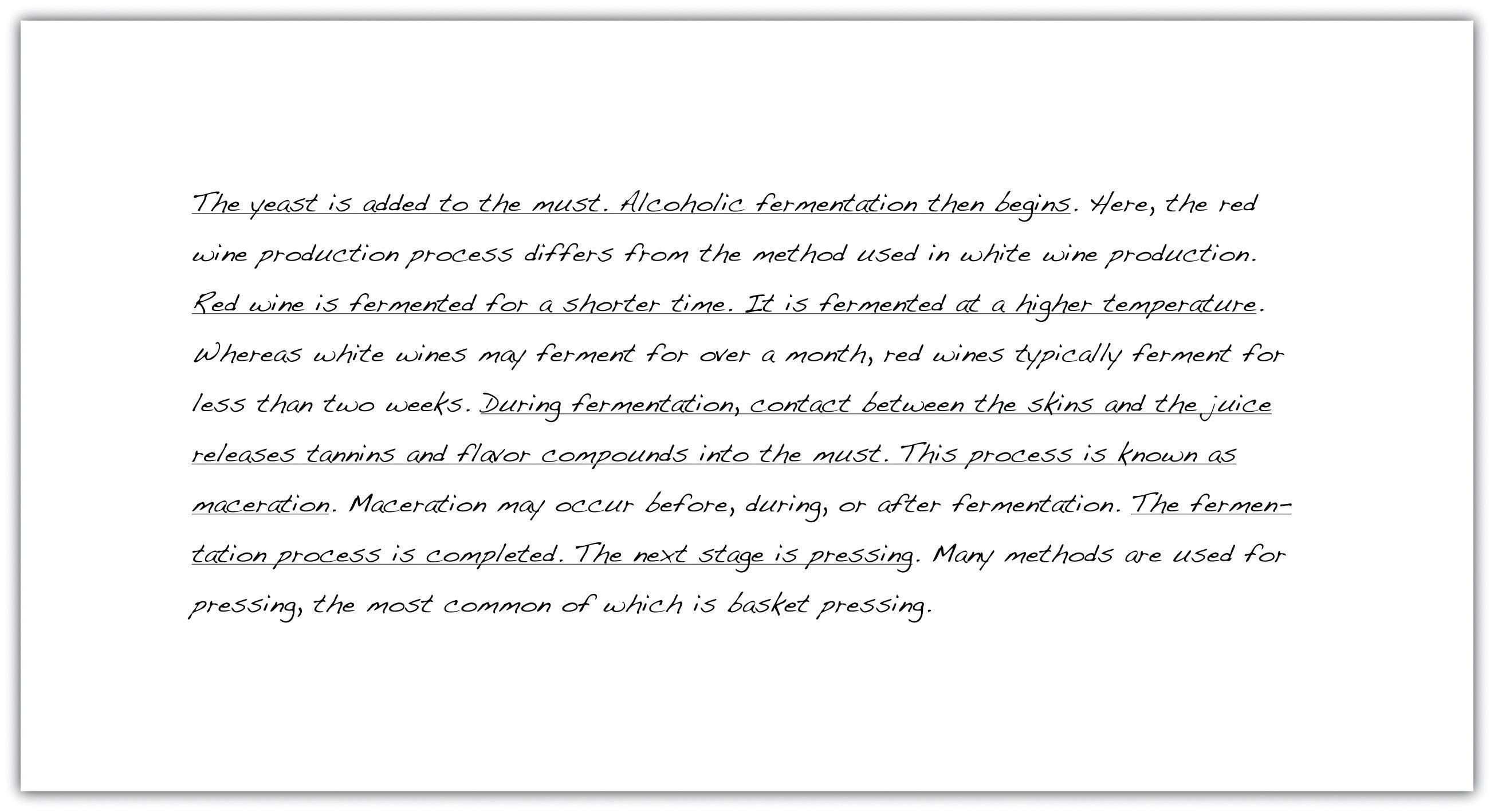
Key Takeaways
- Coordination and subordination join two sentences with related ideas.
- Coordination joins sentences with related and equal ideas, whereas subordination joins sentences with related but unequal ideas.
- Sentences can be coordinated using either a coordinating conjunction and a comma or a conjunctive adverb and a semicolon.
- Subordinate sentences are characterized by the use of a subordinate conjunction.
- In a subordinate sentence, a comma is used to separate the main clause from the dependent clause if the dependent clause is placed at the beginning of the sentence.
7.3 Parallelism
Learning Objectives
- Identify sentences that are parallel and not parallel.
- Identify ways to create parallelism in writing.
- Write and revise sentences using parallelism.
Earlier in this chapter, we learned that increasing sentence variety adds interest to a piece of writing and makes the reading process more enjoyable for others. Using a mixture of sentence lengths and patterns throughout an essay is an important writing technique. However, it is equally important to avoid introducing variation within individual sentences. A strong sentence is composed of balanced parts that all have the same structure. In this section, we will examine how to create a balanced sentence structure by using parallelismUsing the same grammatical structure to express equal ideas in a sentence. Parallelism may occur at the word, phrase, or clause level..
Using Parallelism
Parallelism is the use of similar structure in related words, clauses, or phrases. It creates a sense of rhythm and balance within a sentence. As readers, we often correct faulty parallelismA failure to create grammatically parallel structures in a sentence.—a lack of parallel structure—intuitively because an unbalanced sentence sounds awkward and poorly constructed. Read the following sentences aloud:
Faulty parallelism: Kelly had to iron, do the washing, and shopping before her parents arrived.
Faulty parallelism: Driving a car requires coordination, patience, and to have good eyesight.
Faulty parallelism: Ali prefers jeans to wearing a suit.
All of these sentences contain faulty parallelism. Although they are factually correct, the construction is clunky and confusing. In the first example, three different verb forms are used. In the second and third examples, the writer begins each sentence by using a noun (coordination, jeans), but ends with a phrase (to have good eyesight, wearing a suit). Now read the same three sentences that have correct parallelism.
Correct parallelism: Kelly had to do the ironing, washing, and shopping before her parents arrived.
Correct parallelism: Driving a car requires coordination, patience, and good eyesight.
Correct parallelism: Ali prefers wearing jeans to wearing a suit.
When these sentences are written using a parallel structure, they sound more aesthetically pleasing because they are balanced. Repetition of grammatical construction also minimizes the amount of work the reader has to do to decode the sentence. This enables the reader to focus on the main idea in the sentence and not on how the sentence is put together.
Tip
A simple way to check for parallelism in your writing is to make sure you have paired nouns with nouns, verbs with verbs, prepositional phrases with prepositional phrases, and so on. Underline each element in a sentence and check that the corresponding element uses the same grammatical form.
Creating Parallelism Using Coordinating Conjunctions
When you connect two clauses using a coordinating conjunction (for, and, nor, but, or, yet, so), make sure that the same grammatical structure is used on each side of the conjunction. Take a look at the following example:
Faulty parallelism: When I walk the dog, I like to listen to music and talking to friends on the phone.
Correct parallelism: When I walk the dog, I like listening to music and talking to friends on the phone.
The first sentence uses two different verb forms (to listen, talking). In the second sentence, the grammatical construction on each side of the coordinating conjunction (and) is the same, creating a parallel sentence.
The same technique should be used for joining items or lists in a series:
Faulty parallelism: This committee needs to decide whether the company should reduce its workforce, cut its benefits, or lowering workers’ wages.
Correct parallelism: This committee needs to decide whether the company should reduce its workforce, cut its benefits, or lower workers’ wages.
The first sentence contains two items that use the same verb construction (reduce, cut) and a third item that uses a different verb form (lowering). The second sentence uses the same verb construction in all three items, creating a parallel structure.
Exercise 1
On your own sheet of paper, revise each of the following sentences to create parallel structure using coordinating conjunctions.
- Mr. Holloway enjoys reading and to play his guitar at weekends.
- The doctor told Mrs. Franklin that she should either eat less or should exercise more.
- Breaking out of the prison compound, the escapees moved carefully, quietly, and were quick on their feet.
- I have read the book, but I have not watched the movie version.
- Deal with a full inbox first thing in the morning, or by setting aside short periods of time in which to answer e-mail queries.
Collaboration
Please share with a classmate and compare your answers.
Creating Parallelism Using Than or As
When you are making a comparison, the two items being compared should have a parallel structure. Comparing two items without using parallel structure can lead to confusion about what is being compared. Comparisons frequently use the words than or as, and the items on each side of these comparison words should be parallel. Take a look at the following example:
Faulty parallelism: Swimming in the ocean is much tougher than a pool.
Correct parallelism: Swimming in the ocean is much tougher than swimming in a pool.
In the first sentence, the elements before the comparison word (than) are not equal to the elements after the comparison word. It appears that the writer is comparing an action (swimming) with a noun (a pool). In the second sentence, the writer uses the same grammatical construction to create a parallel structure. This clarifies that an action is being compared with another action.
To correct some instances of faulty parallelism, it may be necessary to add or delete words in a sentence.
Faulty parallelism: A brisk walk is as beneficial to your health as going for a run.
Correct parallelism: Going for a brisk walk is as beneficial to your health as going for a run.
In this example, it is necessary to add the verb phrase going for to the sentence in order to clarify that the act of walking is being compared to the act of running.
Exercise 2
On your own sheet of paper, revise each of the following sentences to create parallel structure using than or as.
- I would rather work at a second job to pay for a new car than a loan.
- How you look in the workplace is just as important as your behavior.
- The firefighter spoke more of his childhood than he talked about his job.
- Indian cuisine is far tastier than the food of Great Britain.
- Jim’s opponent was as tall as Jim and he carried far more weight.
Collaboration
Please share with a classmate and compare your answers.
Creating Parallelism Using Correlative Conjunctions
A correlative conjunctionA paired conjunction that connects two equal parts of a sentence and shows the relationship between them. Common correlative conjunctions include both…and, neither…nor, and either…or. is a paired conjunction that connects two equal parts of a sentence and shows the relationship between them. Common correlative conjunctions include the following:
- either…or
- not only…but also
- neither…nor
- whether…or
- rather…than
- both…and
Correlative conjunctions should follow the same grammatical structure to create a parallel sentence. Take a look at the following example:
Faulty parallelism: We can neither wait for something to happen nor can we take evasive action.
Correct parallelism: We can neither wait for something to happen nor take evasive action.
When using a correlative conjunction, the words, phrases, or clauses following each part should be parallel. In the first sentence, the construction of the second part of the sentence does not match the construction of the first part. In the second sentence, omitting needless words and matching verb constructions create a parallel structure. Sometimes, rearranging a sentence corrects faulty parallelism.
Faulty parallelism: It was both a long movie and poorly written.
Correct parallelism: The movie was both long and poorly written.
Tip
To see examples of parallelism in use, read some of the great historical speeches by rhetoricians such as Abraham Lincoln and Martin Luther King Jr. Notice how they use parallel structures to emphasize important points and to create a smooth, easily understandable oration.
Here is a link to text, audio, video, and the music of Martin Luther King’s speech “I Have a Dream”: http://www.mlkonline.net/dream.html.
Writing at Work
Speechwriters use parallelism not only within sentences but also throughout paragraphs and beyond. Repeating particular key phrases throughout a speech is an effective way of tying a paragraph together as a cohesive whole and creating a sense of importance. This technique can be adapted to any piece of writing, but it may be especially useful for creating a proposal or other type of persuasive workplace document.
Note that the spelling and grammar checker on most word processors will not draw attention to faulty parallelism. When proofreading a document, read it aloud and listen for sentences that sound awkward or poorly phrased.
Exercise 3
On your own sheet of paper, revise each of the following sentences to create parallel structure using correlative conjunctions.
- The cyclist owns both a mountain bike and has a racing bike.
- The movie not only contained lots of action, but also it offered an important lesson.
- My current job is neither exciting nor is it meaningful.
- Jason would rather listen to his father than be taking advice from me.
- We are neither interested in buying a vacuum cleaner nor do we want to utilize your carpet cleaning service.
Collaboration
Please share with a classmate and compare your answers.
Exercise 4
Read through the following excerpt from Alex’s essay and revise any instances of faulty parallelism. Rewrite the sentences to create a parallel structure.

Key Takeaways
- Parallelism creates a sense of rhythm and balance in writing by using the same grammatical structure to express equal ideas.
- Faulty parallelism occurs when elements of a sentence are not balanced, causing the sentence to sound clunky and awkward.
- Parallelism may be created by connecting two clauses or making a list using coordinating conjunctions; by comparing two items using than or as; or by connecting two parts of a sentence using correlative conjunctions.
7.4 Refining Your Writing: End-of-Chapter Exercises
Learning Objectives
- Use the skills you have learned in the chapter.
- Work collaboratively with other students.
- Work with a variety of academic and on-the-job, real-world examples.
Exercises
-
Children’s stories are deliberately written in short, simple sentences to avoid confusion. Most sentences are constructed using the standard subject-verb-object format. Choose a children’s story that is suitable for eight- to ten-year-olds. Rewrite a chapter of the story so that it appeals to a slightly older age group, by editing for sentence variety. Experiment with the techniques you learned in Section 7.1 "Sentence Variety", including the three different ways to vary sentence structure at the beginning of a sentence and the three different ways to connect ideas between sentences. Compare the revised chapter with the original version and consider how sentence variety can be used to target a particular audience.
Collaboration
Please share with a classmate and compare your answers.
-
Compile a selection of real-life writing samples from the workplace or around the home. You might like to choose one of the following: e-mail, junk mail, personal letter, company report, social networking page, local newspaper, bulletin-board posting, or public notice. Choose two samples that lack sentence variety. Highlight areas of each writing sample that you would edit for sentence variety and explain why. Replace any recognizable name with a pseudonym, or a fictitious name.
Collaboration
Please share with a classmate and compare your answers.
- Group activity. Choose a well-known speech, such as Martin Luther King’s “I Have a Dream” speech, Winston Churchill’s “Blood, Toil, Tears, and Sweat” speech, or Barack Obama’s inaugural address. Make a copy of the speech and, as a group, underline examples of parallelism. Discuss the effects of using parallelism and consider whether it is always used to achieve the same result or whether the writer manipulates parallelism to create a variety of responses among his or her audience.
-
Group activity. Working in a small group, select a workplace document or academic essay. Examine each paragraph and identify examples of sentence variety, coordination and subordination, and parallelism. Then, choose one particular paragraph and discuss the following questions:
- Does the writer use sentence variety effectively?
- Does the writer connect his or her ideas effectively?
- Does the writer use subordination and coordination correctly?
- Does the writer use parallelism to emphasize his or her points?
As a group, identify the weaker areas of the paragraph and rewrite them. Focus on sentence structure and sentence variation. Use coordinating conjunctions and subordinating conjunctions to join sentences.
-
Choose a college essay or a recent piece of writing from your work or everyday life. Use the techniques you have learned throughout this chapter to edit your writing for sentence variety, appropriate coordination and subordination, and parallelism. When you have finished, compare the two versions and write a brief analysis of how sentence variety, coordination and subordination, and parallelism help refine a piece of writing.
Collaboration
Please share with a classmate and compare your answers.




